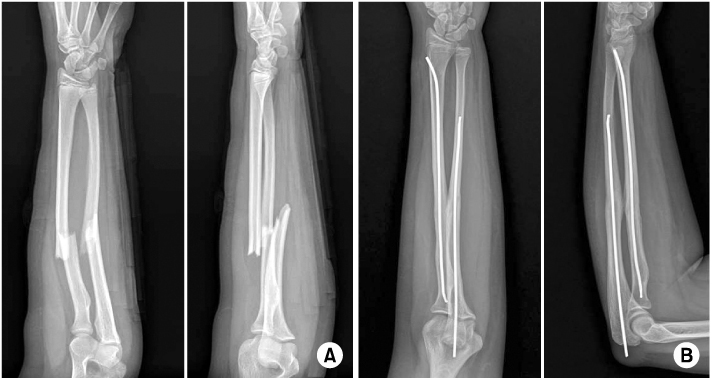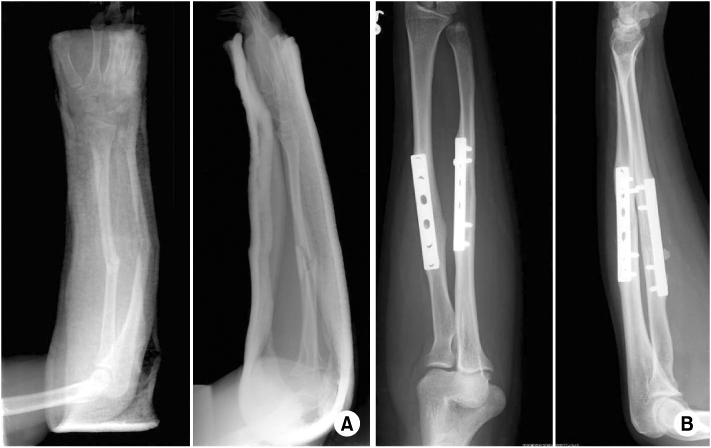J Korean Fract Soc.
2012 Oct;25(4):335-341. 10.12671/jkfs.2012.25.4.335.
Surgical Treatment of Both Forearm Bone Fracture
- Affiliations
-
- 1Department of Orthopedic Surgery, Incheon St. Mary's Hospital, The Catholic University of Korea College of Medicine, Incheon, Korea.
- 2Department of Orthopedic Surgery, Yonsei University College of Medicine, Seoul, Korea. pedhkim@yuhs.ac
- KMID: 1434077
- DOI: http://doi.org/10.12671/jkfs.2012.25.4.335
Abstract
- No abstract available.
MeSH Terms
Figure
Reference
-
1. Arunachalam VS, Griffiths JC. Fracture recurrence in children. Injury. 1975. 7:37–40.
Article2. Bauer G, Arand M, Mutschler W. Post-traumatic radioulnar synostosis after forearm fracture osteosynthesis. Arch Orthop Trauma Surg. 1991. 110:142–145.
Article3. Bellemans M, Lamoureux J. Indications for immediate percutaneous intramedullary nailing of complete diaphyseal forearm shaft fractures in children. Acta Orthop Belg. 1995. 61:Suppl 1. 169–172.4. Bhaskar AR, Roberts JA. Treatment of unstable fractures of the forearm in children. Is plating of a single bone adequate? J Bone Joint Surg Br. 2001. 83:253–258.5. Carey PJ, Alburger PD, Betz RR, Clancy M, Steel HH. Both-bone forearm fractures in children. Orthopedics. 1992. 15:1015–1019.
Article6. Chess DG, Hyndman JC, Leahey JL, Brown DC, Sinclair AM. Short arm plaster cast for distal pediatric forearm fractures. J Pediatr Orthop. 1994. 14:211–213.
Article7. Crawford AH. Pitfalls and complications of fractures of the distal radius and ulna in childhood. Hand Clin. 1988. 4:403–413.
Article8. Creasman C, Zaleske DJ, Ehrlich MG. Analyzing forearm fractures in children. The more subtle signs of impending problems. Clin Orthop Relat Res. 1984. (188):40–53.9. Crenshaw AH, Zinar DM, Pickering RM. Intramedullary nailing of forearm fractures. Instr Course Lect. 2002. 51:279–289.10. Cullen MC, Roy DR, Giza E, Crawford AH. Complications of intramedullary fixation of pediatric forearm fractures. J Pediatr Orthop. 1998. 18:14–21.
Article11. Daruwalla JS. A study of radioulnar movements following fractures of the forearm in children. Clin Orthop Relat Res. 1979. (139):114–120.
Article12. Davis DR, Green DP. Forearm fractures in children: pitfalls and complications. Clin Orthop Relat Res. 1976. (120):172–183.13. Deluca PA, Lindsey RW, Ruwe PA. Refracture of bones of the forearm after the removal of compression plates. J Bone Joint Surg Am. 1988. 70:1372–1376.
Article14. Flynn JM. Pediatric forearm fractures: decision making, surgical techniques, and complications. Instr Course Lect. 2002. 51:355–360.15. Flynn JM, Waters PM. Single-bone fixation of both-bone forearm fractures. J Pediatr Orthop. 1996. 16:655–659.
Article16. Greenbaum B, Zionts LE, Ebramzadeh E. Open fractures of the forearm in children. J Orthop Trauma. 2001. 15:111–118.
Article17. Haasbeek JF, Cole WG. Open fractures of the arm in children. J Bone Joint Surg Br. 1995. 77:576–581.
Article18. Holdsworth BJ, Sloan JP. Proximal forearm fractures in children: residual disability. Injury. 1982. 14:174–179.
Article19. Kay S, Smith C, Oppenheim WL. Both-bone midshaft forearm fractures in children. J Pediatr Orthop. 1986. 6:306–310.
Article20. Kramhøft M, Solgaard S. Displaced diaphyseal forearm fractures in children: classification and evaluation of the early radiographic prognosis. J Pediatr Orthop. 1989. 9:586–589.21. Litton LO, Adler F. Refracture of the forearm in children: a frequent complication. J Trauma. 1963. 3:41–51.22. Luhmann SJ, Schootman M, Schoenecker PL, Dobbs MB, Gordon JE. Complications and outcomes of open pediatric forearm fractures. J Pediatr Orthop. 2004. 24:1–6.
Article23. Metaizeau JP, Ligier JN. Surgical treatment of fractures of the long bones in children. Interference between osteosynthesis and the physiological processes of consolidation. Therapeutic indications. J Chir (Paris). 1984. 121:527–537.24. Nielsen AB, Simonsen O. Displaced forearm fractures in children treated with AO plates. Injury. 1984. 15:393–396.
Article25. Noonan KJ, Price CT. Forearm and distal radius fractures in children. J Am Acad Orthop Surg. 1998. 6:146–156.
Article26. Ogonda L, Wong-Chung J, Wray R, Canavan B. Delayed union and non-union of the ulna following intramedullary nailing in children. J Pediatr Orthop B. 2004. 13:330–333.
Article27. Ortega R, Loder RT, Louis DS. Open reduction and internal fixation of forearm fractures in children. J Pediatr Orthop. 1996. 16:651–654.
Article28. Prevot J, Lascombes P, Guichet JM. Elastic stable intramedullary nailing for forearm fractures in children and adolescents. Orthop Trans. 1995. 20:30.29. Price CT. Surgical management of forearm and distal radius fractures in children and adolescents. Instr Course Lect. 2008. 57:509–514.30. Price CT, Scott DS, Kurzner ME, Flynn JC. Malunited forearm fractures in children. J Pediatr Orthop. 1990. 10:705–712.
Article31. Richter D, Ostermann PA, Ekkernkamp A, Muhr G, Hahn MP. Elastic intramedullary nailing: a minimally invasive concept in the treatment of unstable forearm fractures in children. J Pediatr Orthop. 1998. 18:457–461.
Article32. Rodríguez-Merchán EC. Pediatric fractures of the forearm. Clin Orthop Relat Res. 2005. (432):65–72.
Article33. Schwarz N, Pienaar S, Schwarz AF, Jelen M, Styhler W, Mayr J. Refracture of the forearm in children. J Bone Joint Surg Br. 1996. 78:740–744.
Article34. Vainionpää S, Böstman O, Pätiälä H, Rokkanen P. Internal fixation of forearm fractures in children. Acta Orthop Scand. 1987. 58:121–123.
Article35. Van der Reis WL, Otsuka NY, Moroz P, Mah J. Intramedullary nailing versus plate fixation for unstable forearm fractures in children. J Pediatr Orthop. 1998. 18:9–13.
Article36. Vince KG, Miller JE. Cross-union complicating fracture of the forearm. Part II: children. J Bone Joint Surg Am. 1987. 69:654–661.37. Voto SJ, Weiner DS, Leighley B. Use of pins and plaster in the treatment of unstable pediatric forearm fractures. J Pediatr Orthop. 1990. 10:85–89.
Article38. Wyrsch B, Mencio GA, Green NE. Open reduction and internal fixation of pediatric forearm fractures. J Pediatr Orthop. 1996. 16:644–650.
Article39. Younger AS, Tredwell SJ, Mackenzie WG. Factors affecting fracture position at cast removal after pediatric forearm fracture. J Pediatr Orthop. 1997. 17:332–336.
Article40. Yung SH, Lam CY, Choi KY, Ng KW, Maffulli N, Cheng JC. Percutaneous intramedullary Kirschner wiring for displaced diaphyseal forearm fractures in children. J Bone Joint Surg Br. 1998. 80:91–94.
Article
- Full Text Links
- Actions
-
Cited
- CITED
-
- Close
- Share
- Similar articles
-
- Reconstruction of traumatic deficiency of forearm bone: report of Two Cases
- A Clinical Study on Nonunion of the Forearm Fracture
- Medullary fixation with rush pin of fracture of the forearm bone in adults
- Median nerve entrapment in a callus fracture following a pediatric both-bone forearm fracture: A case report and literature review
- A Clinical Analysis of the Fracture of the Forearm Bone






